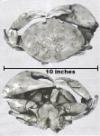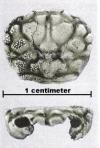Got crabs? I'm infested with crabs. No! Not those kind. Fossil crabs. In July 1996 a publication came out describing 25 new decapods from the Middle Eocene of North and South Carolina. I met the author not long after when I acted as a guide into one of the local quarries. Our friendship was instantaneous and we are now working together on a major publication. The 25 decapods he had described had come from the Santee Limestone formation. It's a hard (like concrete)limestone that runs from southern North Carolina almost to Georgia. At the end of his visit he asked me to look out for more species. He believed there could be as many as 40 species in the formation. And he was right! Over the last 10 years I've amassed the largest Eocene decapod collection in North America. Not only have I collected many specimens of the original 25, but have found 15 new species. Three have already been publish. One has my name. No! It's not a "bumi". And one is going to press in Mexico as you read this. The 9" crab gets my name on it. Naturally! The others I'm dedicating to professional, and amateur, collectors that have contributed to the science of paleontology. The quarry is now gone. Reclaimed and filled with water. It was fun while it lasted. One of the interesting things I've discovered is the intense interest fossil collectors have in crabs. They seem to be centerpieces of many a private collection. My friend also pointed out an interesting fact. People who grew up around the ocean have more of a fascination with fossil crabs. I suspect it stems from seeing the little buggers in action with claws snapping, tearing, grinding.... You get the idea. Another fact is that most of the carapaces you find have been molted. Crabs continuously shed their exoskeleton as they grow. Most of the shed material will be consumed by the same crab for the minerals. This helps the next exoskeleton to "harden" up. That's why you rarely find complete skeletons with limbs. And why you do find isolated claws. Some modern eels use this against the crabs. They place crab exoskeletons outside of their dens. When a crab shows up to consume the exoskeleton, it's consumed. And adds it's own exoskeleton to the trap. Tricky! Many complete fossil crabs are found in formations laid down in a close shore, river basin, environment. Flash floods will cause sudden increases in current and silt flowing into the ocean. This covers the crabs alive. The classic position, with both claws pulled up tight to the body, usually indicates this kind of death. A local formation was recently named that has produced some exceptionally complete crabs. One of them is a new species that will be published soon. I've kept a few for my own reference material. The one I have shown here was not the smallest one found. They ranged from .5 inches to 4.5 inches in width. After the publication comes out I'll add some spectacular pictures of this new species. Gota go now! Mrs. Bum wants the computer and is getting a little crabby.
|
Location
| Berkeley County, South Carolina, USA |
| ID | 688 |
| Member | paleobum |
| Date Added | 10/19/2006 |
 |
| This new species is a little beauty. It's about 80% complete. A lot of microscope work involved. But worth it! |
|
 |
| A great Acantholambrus baumi. I was able to save a lot of the carapace spines. Around 10 hours work to get this one out in this condition. I use a special home made electric scribe to remove the matrix a pin head size at a time. |
|
 |
| A Martinetta .......i. This one was named after me. Mrs. Bum says she sees a close resemblance. I brought it home in a thirty pound chunk of limestone. All I could see was the right claw. But what a CLAW! I lost count of the hours involved. When I found myself wanting to rush, I would reluctantly put it away for a few days. You have to be patient to get great results. |
|
 |
| Another one of my finds. Eohalimede sandersi. Small, but not the smallest, from my collecting efforts. The smallest new species I've found, and prepared, was 5mm long. Strangely enough, it might be related to Eocene fossil crabs from Japan. |
|
|